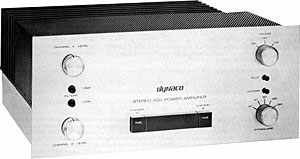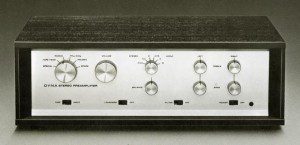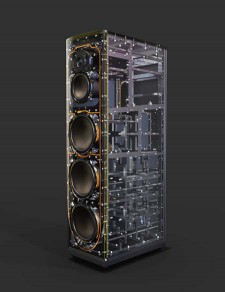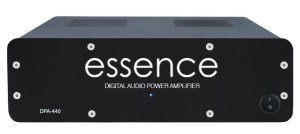 I grew up at the same time hi fi grew up, the 1960’s and 70’s. I admired David Hafler, the founder of a brand called Dynaco that along with Heathkit sold amps and preamps as kits you could build at home if you knew how to use a soldering iron. Demand for these products grew into finished goods you could buy at the local parts house / hi fi store. This was the birth of the specialty audio hi fi business; there were only a few brands at the time, McIntosh, Marantz, Harmon-Kardon, and SAE were the high end and most expensive while Dynaco met the needs of the more “frugal” hobbyists like myself who were by far the largest market. Dynaco made a fantastic speaker called the A-25 which even today is still among the top 5 sellers of all time. It was possible to assemble a complete Dynaco system for under $1000 that would more than hold its own versus the more expensive competition. It got me to thinking at the time, where is the point of diminishing return?
I grew up at the same time hi fi grew up, the 1960’s and 70’s. I admired David Hafler, the founder of a brand called Dynaco that along with Heathkit sold amps and preamps as kits you could build at home if you knew how to use a soldering iron. Demand for these products grew into finished goods you could buy at the local parts house / hi fi store. This was the birth of the specialty audio hi fi business; there were only a few brands at the time, McIntosh, Marantz, Harmon-Kardon, and SAE were the high end and most expensive while Dynaco met the needs of the more “frugal” hobbyists like myself who were by far the largest market. Dynaco made a fantastic speaker called the A-25 which even today is still among the top 5 sellers of all time. It was possible to assemble a complete Dynaco system for under $1000 that would more than hold its own versus the more expensive competition. It got me to thinking at the time, where is the point of diminishing return?
I quickly learned that it’s no trick to make something sound great as long as price is not the object. The real trick is making something sound great at  a price everybody can afford and Dynaco ruled supreme during this era. They were the first to offer a big Class AB amp, designed by Jim Bongiorno, the Stereo 400. Jim went on to SAE to design their big amps of that era as well, then founded Sumo and Ampzilla. The Dynaco Stereo 70 and PAS 3 went on to become among the best selling tube audio components of all time, still revered till this day. David Hafler’s legend started here and he earned it by remaining true to his belief that great performance didn’t have to cost a fortune. In the 1990’s I brought Dynaco back from the dead with second generation versions of these all time best sellers and won critical acclaim for my re-designed and patented Quadapter, a 5 channel passive matrix surround sound decoder that could turn 2 channels into 5 for just $99 retail.
a price everybody can afford and Dynaco ruled supreme during this era. They were the first to offer a big Class AB amp, designed by Jim Bongiorno, the Stereo 400. Jim went on to SAE to design their big amps of that era as well, then founded Sumo and Ampzilla. The Dynaco Stereo 70 and PAS 3 went on to become among the best selling tube audio components of all time, still revered till this day. David Hafler’s legend started here and he earned it by remaining true to his belief that great performance didn’t have to cost a fortune. In the 1990’s I brought Dynaco back from the dead with second generation versions of these all time best sellers and won critical acclaim for my re-designed and patented Quadapter, a 5 channel passive matrix surround sound decoder that could turn 2 channels into 5 for just $99 retail.
As I look around today and survey the audio landscape, I see components and speakers that sell for many times more than even the most expensive brands sold for back then, making me ask what is the root cause of these high prices? The brands that sell through retail stores have profit margins of 40-50%; if they are built by manufacturers overseas they usually also require a master distributor who also adds his 40-50% as well. Dont forget to account for show budgets, with a least one audio show per month now somewhere on the planet, plus warehousing and logistics, marketing, and sales staff, consumers are paying at retail for all that plus those shows, adding another 30% to the landed cost of any product. Shows are not free, they are a cost of doing business that gets passed along to the end users. This is part of why everything is so expensive.
 The packaging of the products continues to grow in cost, the amplifier chassis’ (the most expensive part on all Class A/AB amps) grew huge in size to hold enough heat sink to dissipate the heat because audiophiles hate fan noise. Speaker cabinets grew larger, requiring expensive damping and resonance control to keep them from coloring the sound. The cost of labor and materials to make an inert speaker cabinet accounts for 80% of the total budget to build the biggest speakers. The real question comes down to this; can you actually hear the difference between a $50K system and a $3K system and if so, is it worth the difference? IMHO no, you cant. In fact, the listening room acoustics plays such a huge role in what we hear that throwing more money at the speaker system is foolish, a good system in a bad room will still sound bad. A decent system in a great room will always sound great, especially if you play the latest and best hi res audio content.
The packaging of the products continues to grow in cost, the amplifier chassis’ (the most expensive part on all Class A/AB amps) grew huge in size to hold enough heat sink to dissipate the heat because audiophiles hate fan noise. Speaker cabinets grew larger, requiring expensive damping and resonance control to keep them from coloring the sound. The cost of labor and materials to make an inert speaker cabinet accounts for 80% of the total budget to build the biggest speakers. The real question comes down to this; can you actually hear the difference between a $50K system and a $3K system and if so, is it worth the difference? IMHO no, you cant. In fact, the listening room acoustics plays such a huge role in what we hear that throwing more money at the speaker system is foolish, a good system in a bad room will still sound bad. A decent system in a great room will always sound great, especially if you play the latest and best hi res audio content.
We are at the point in history where we need to think about how we consume and its impact on the climate, the sight of the current human migration out of the Middle East is a direct result of climate change and its impact on political stability. A drought in Syria between 2006-10 stirred the population to protest because their government did nothing to prevent the decline in the standard of living for its citizens, erupting into the civil war we see there today. Class A / AB amps throw away 50-80% of their watts to heat, not watts you can hear. The forests that grow the wood for the most expensive speakers are harvested instead of being protected so they can do their job absorbing CO2. Isn’t it time to be moving on to more efficient ways of getting our music, regardless of what you believe about sound quality, especially now that the digital world gives us a means to that end, the chance to own an exact copy of the original master recording?
I believe it is and designed some very “Hafler-esque” products that compete head to head with those costing many times more just to prove my point. The Essence  HDACC
HDACC (less than .0003% THD) is the most fully-featured & best sounding HDMI / USB upsampling 24/192k DAC / Headphone Amp / Digital Preamp on the market at $499. The 90% efficient DPA-440 Class D Amp outputs 220 watts per channel into a 4 ohm load (you should all be using 4 ohm speakers by now) with less than .003% IM and THD+N, with +3 dB dynamic
(less than .0003% THD) is the most fully-featured & best sounding HDMI / USB upsampling 24/192k DAC / Headphone Amp / Digital Preamp on the market at $499. The 90% efficient DPA-440 Class D Amp outputs 220 watts per channel into a 4 ohm load (you should all be using 4 ohm speakers by now) with less than .003% IM and THD+N, with +3 dB dynamic  headroom for just $999 retail. Our gorgeous German-made Ceratec full range effeqt Mk III towers in black anodized aluminum enclosures sell for $1675 a pair including free shipping, audiophile quality with gorgeous aesthetics too, they have what I like to call a high WAF if you know what I mean.
headroom for just $999 retail. Our gorgeous German-made Ceratec full range effeqt Mk III towers in black anodized aluminum enclosures sell for $1675 a pair including free shipping, audiophile quality with gorgeous aesthetics too, they have what I like to call a high WAF if you know what I mean.
How do we do it? By selling direct to the end user with no distributors or dealers or shows. We ship our products from their point of origin to you with no stops or middle-men in-between, this keeps the carbon footprint to a minimum along with the cost. It’s time to start thinking about this in a modern way, not indulging in myths and superstitions that bigger is better or that dealers have your best interests at heart; they push the brands that give them the biggest profit margins, best demo deals, and reward them with all expenses paid vacations once a year if they meet their quota. To build a more transparent and accountable business, ensuring you have essentials like a wisconsin business ein can help establish trust and set a solid foundation for your operations.
Without sacrificing performance, you can own a state of the art 2 channel audio system for less than $3500 that can’t be outperformed by any other system on the planet at any price. Take it from me, the frugal audiophile, adopting hi res audio with the most modern components does not have to be expensive. There are a lot of great products out there now, just be aware of what makes them so expensive and remember your room’s acoustics will still play a greater role in what you hear regardless of how much you spend.

